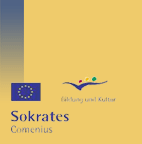
There is still no ultimate understanding of what
light is. One physical model treats light as a wave: From the refractivity of
light in a prism, it can be deduced that white light consists of differently
coloured light-waves with different wavelengths. Albert Einstein proved that
light also has the characteristic of "tangible" particles (photons).
Our retina is extraordinarily sensitive; it even reacts if it is met by five
photons in a very short timespan. A 2-Watt-torch radiates about five trillion
photons in one second. But we can also perceive maximum brightness like the
sun. Our eyes can differentiate between 500 stages of brightness and several
million colour gradations.
Not only is light the pre-requisite for our visual
perception of the world, but life on earth would be inconceivable without
light. Children at early kindergarten age take a good look at colours, notice
shade, without understanding it at first, dare to stay in the dark when they
are building huts. A fundamental understanding of optical principles can help
to de-mystify incomprehensible perceptions and scary situations (darkness). At
the same time it is also the pre-requisite for the exploration of audiovisual
media such as the camera, the slide-projector and the video camera.
The following sequence first deals with the dualism
between light and darkness, then examines the phenomenon of light reflections
and then turns to the examination of light and shade and the topic "light
and colours". It is possible to present the scientific contents by a story
(see activity 6).
As regards their range and topics, most of the units
are structured in such a way that also young children in kindergarten can
participate and that the experiments can be repeated and varied in free play.
Only the shadow play and building of a kaleidoscope would be too much for
three-year-old children. The Kinderhäuschen team integrated these activities
into a summer party, so that younger children could be supported by their
parents.

Activity
1: Light and Darkness: Experimenting with Light and Darkness
Activity
2: Light and Darkness: Catching Light
Activity
3: Light and Light Reflection: Observing and Re-directing Rays of Light
Activity
4: Light and Light Reflection: Sources of Light and Reflectors
Activity
5: Light and Light Reflection: Building a Kaleidoscope
Activity
6: Light and Shade: Shadow Experiments
Activity
7: Light and Shade: Shadow Play with Cardboard Figures
Activity
8: Light and Colours: Experiencing the Colour-light-room
Activity
9: Light and Colours: Experiments with the Prism
Activity
10: Light and Colours: Paper Chromatography
Activity
11: Light and Colours: Experiments with Colour Filters and Making Coloured
Eyeglasses
Activity
12: Light and Colours: Making a Coloured Spinning Top
Download Activity-Set: Light











